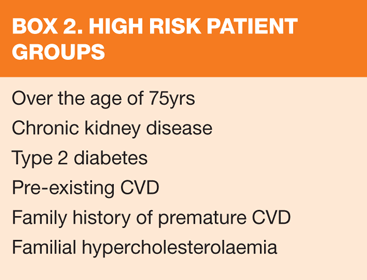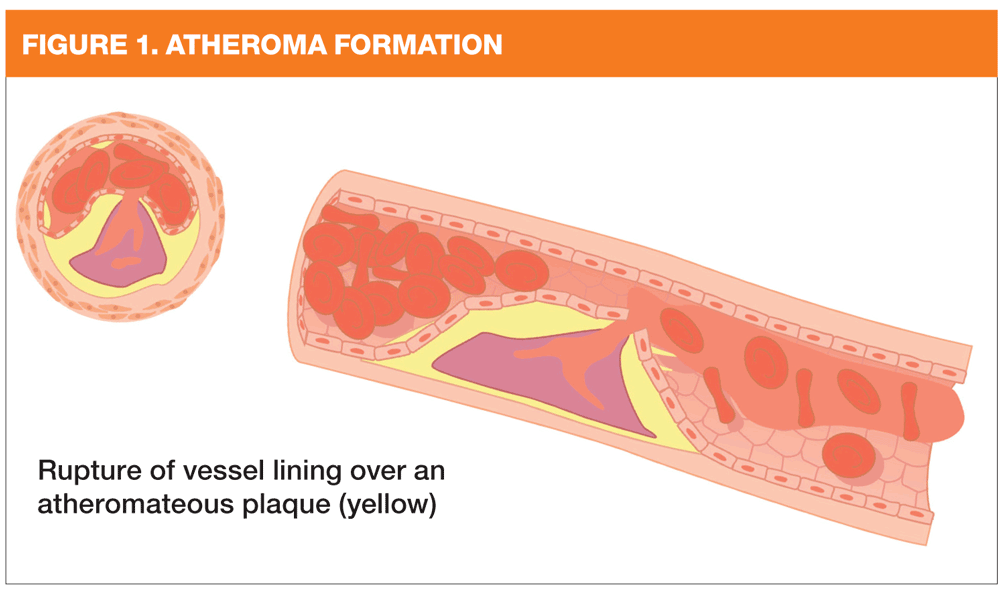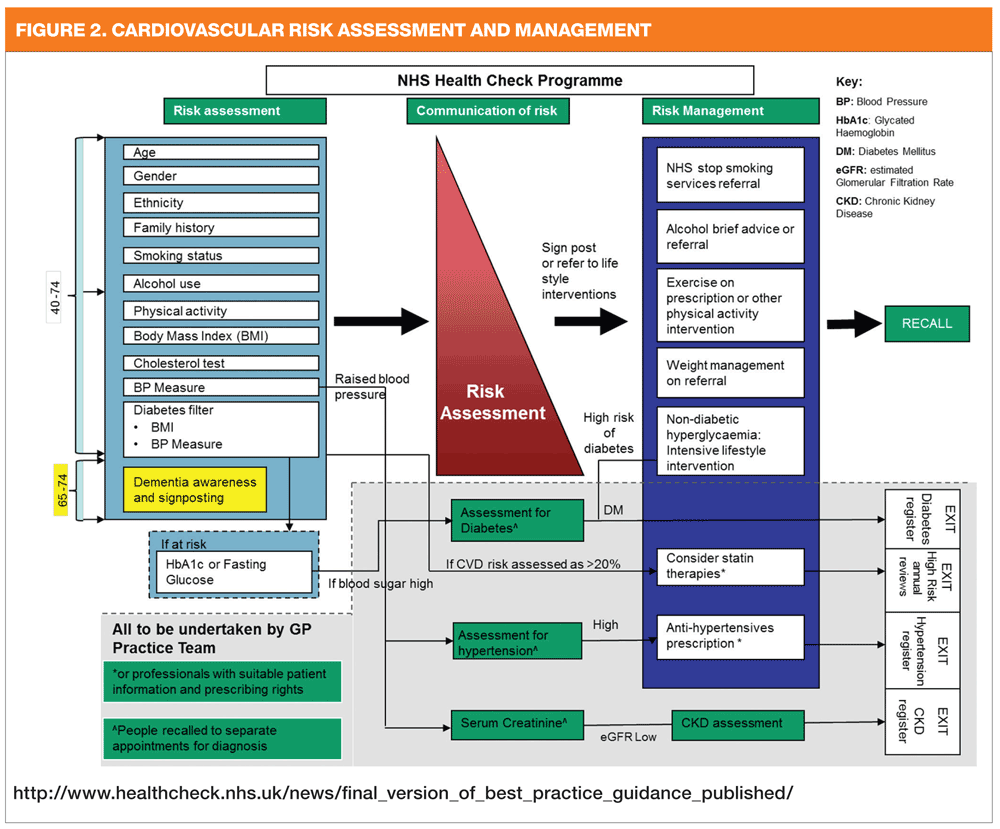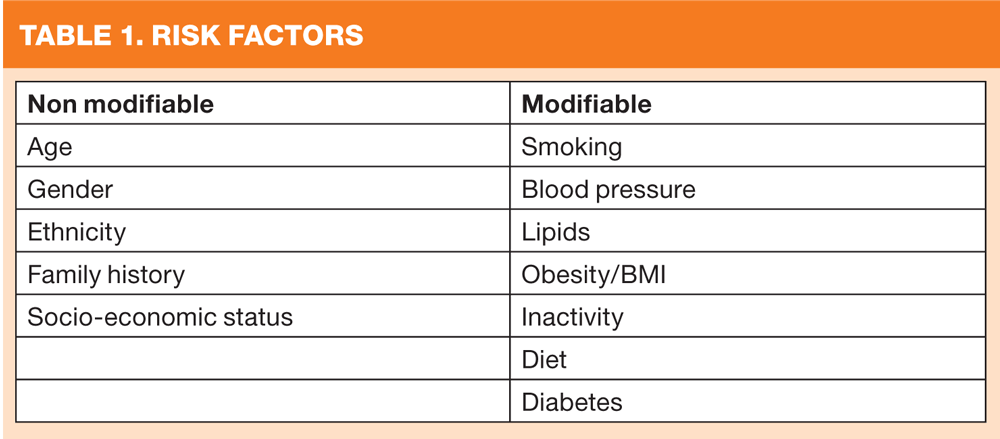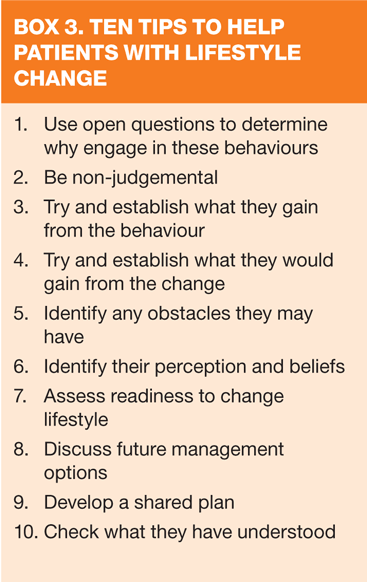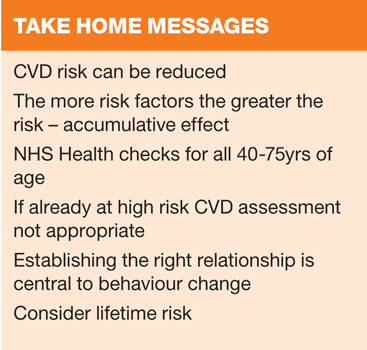Back to basics:assessing cardiovascular risk
Linda Edmunds
Linda Edmunds
RN, MSc, ONC, FETC
CVD Clinical Lead Education for Health, Warwick
Assessing patients’ risk of developing cardiovascular disease is a cornerstone of modern general practice. For those new to the role (or those who could use a refresher) here’s a guide to who, how and what to assess
Coronary heart disease (CHD) is one of many diseases that affect both the heart and blood vessels throughout the body, that collectively are referred to as cardiovascular disease (CVD). Mortality from CVD has decreased over the last decade through a combination of improved drug therapies, surgical interventions and risk factor modifications. Yet despite this overall reduction in mortality it remains the biggest killer in the United Kingdom and in people less than 75 years of age it accounts for 45,000 deaths a year.1
WHAT IS CARDIOVASCULAR DISEASE?
Cardiovascular disease occurs when there is a build-up of plaque on a vessel wall; this is caused by an interaction between the vessel wall and blood components where inflammation plays a role. The plaques have a lipid core and fibrous cap. It is the lining of the vessel wall over the plaque, which may rupture and in turn lead to thrombosis with partial or complete blockage of a vessel. (Figure 1)
This plaque formation can lead to a range of health conditions, depending on which vessel is affected. (Box 1)
Due to the potentially devastating impact that CVD can have on the individual, along with the fact that we know we can reduce an individual’s risk it is important that we understand who, how and what to assess in relation to CVD risk.
WHO TO ASSESS
UK strategy is to carry out a CVD risk assessment on all people between the ages of 40 and 74 years of age to identify those with at least a 20% risk (which is considered to be high risk) of developing symptomatic CVD within 10 years.2-4 However, new guidance from the Joint British Societies (JBS3) says that by using only short term estimates, the long term consequences of modifiable risk factors (Table 1) are overlooked, even if they put someone at high lifetime risk. The new approach considers lifetime risk measurement in recognition of increasing CVD risk with length of exposure to risk factors.5
HOW TO ASSESS
Tools
JBS3 has developed a new risk calculator to estimate both the 10-year risk and lifetime risk of CVD (available at www.jbs3risk.com) which, over time, may supersede the tools currently in use, especially as there is a lack of consensus on which specific tool to use because of the differences in populations. The Scottish Intercollegiate Guidelines Network (SIGN)6 recommends ASIGN, which has been developed specifically for use in the Scottish population, but the NICE guidelines for England and Wales are less prescriptive and suggest using tools which are appropriate to the population being assessed.7 There are a few considerations to bear in mind when using specific tools, of which the more commonly used tools in the UK are:
Framingham8
This is probably the oldest risk assessment tool. It considers multiple risk factors to give a predicted absolute risk over a ten year period. It considers age, sex, blood pressure, total and High Density Lipoprotein (HDL) cholesterol, smoking and presence of diabetes. Framingham has tended to overestimate low risks groups and underestimate high risk groups.
NICE6 recommends increasing the risk score by:
- 1.4 for men with a South Asian background
- 1.5 if one first degree relative has a history of premature CHD
- 2.0 if more than one first degree relative has a history of premature CHD
QRISK29
Includes the same factors as Framingham but also Body Mass Index (BMI), premature family history, social derivation, anti-hypertensive medication, ethnicity and chronic kidney disease. It has been shown to be less likely to overestimate CVD mortality.
ASIGN6
– The risks addressed are similar to Framingham and also include family history and social deprivation; however, this tool has not been validated outside of the Scottish population and it also does appear to overestimate risk.
There are some potential disadvantages of using a risk assessment tool in isolation; treating an individual risk factor may not be as effective as providing a more complex lifestyle intervention, and depending what tool is used, some factors may not be taken into consideration. There is a tendency that the older person is more likely to be treated as their age alone would put them in a higher risk category, while the younger person may not receive treatment as their age would put them into a lower risk category – even if other factors are equal.
The QRISK-lifetime is the latest tool that estimates the lifetime risk of CVD, and this will identify the younger person with a higher lifetime risk of CVD compared with their peers.
THE ASSESSMENT
Many people will be unaware they are at risk of CVD. Alternatively, some people may not want to face up to their CVD risk. These are factors to remember when carrying out a risk assessment, which may be the just the beginning of a long journey of lifestyle changes that are likely to require support in the future. Therefore, developing a good relationship between the assessor and the assessee is fundamental. NICE guidance reminds us that during assessment we should:
- Use jargon free language
- Be aware of a persons’ culture
- Identify any sensory or learning disabilities
- Use appropriate language or visual tools
- Allow time for the consultation and education
- Provide written as well as verbal information7
WHAT TO ASSESS
There are key risk factors for CVD and they can be separated into modifiable and non-modifiable risks.3,10 Modifiable risks are those that we have some control over. (Table 1)
There are other factors which are now known to be associated with increased CVD risk and these include: history of rheumatoid arthritis, chronic kidney disease, atrial fibrillation (AF), high levels of alcohol intake and metabolic syndrome. Metabolic syndrome is a collection of signs which when put together indicate that the individual is at higher risk of developing type 2 diabetes and/or CVD. The risk factors for metabolic syndrome are central obesity (waist >94cm European men and >80 cm European women) and any two of:
- Raised triglycerides >1.7mmol/l
- Low density lipoprotein <1.03mmol/l in men, <1.29mmom/l in women
- Raised BP>130/85
- Raised fasting blood glucose >5.6 mmol/l 3
The guidance for NHS Health checks provides a clear diagram of what should be included in a vascular risk assessment.4 (Figure 2)
RISK FACTORS
Smoking
Smoking increases the risk of coronary artery disease 2 fold and peripheral artery disease 7 fold. The impact is greater for people with diabetes and hypertension10 and is also increased by amount smoked.
Body Mass Index (BMI)
Mortality from vascular disease is increased in those with a BMI>22.5kg/m2, and those at greater risk are those with central obesity, as measured by waist circumference. A weight loss of between 5% and 10% has been shown to improve blood pressure, lipids, and glucose tolerance.
A BMI >25.0kg/m2 would be considered overweight (>23.0kg/m2 for South Asian [SA] origin), BMI >30.0kg/m2 (SA >27.0kgm2) obese, and increased abdominal fat defined as waist circumference >94cm in men, and 80cm in women (90cm SA men, 80cm SA women).10
Diet
The Government estimates that 70,000 premature deaths could be avoided if dietary recommendations were met in full.10 Current guidance suggests:
- Saturated fat should be < 10% total energy intake and total fat intake <30%.
- Omega 3 fatty acids have anti-inflammatory and anti-atherogenic properties and can be found in fish oils. It is recommended to eat fish twice a week of which at least one should be oily fish.
- Fruit and vegetables – the greatest reductions in CVD risk are seen in those who consume 5 or more portions daily
- Plant sterols/stanols lower LDL cholesterol
- Salt – high salt intake is associated with increased risk of CVD. Some studies have shown that a reduction of 1g salt per day would be more cost effective than medication to lower blood pressure. UK guidelines suggest no more than 6 grams per day although the World Health Organization (WHO) suggests 5 grams per day.
Alcohol
High doses of daily alcohol are harmful for the heart and put an individual at greater risk of atrial fibrillation, cardiomyopathy and hypertension. It is recommended no more than 3-4 units daily for men and 2-3 units daily for women with 2 alcohol free days a week.10
Physical activity
WHO has assessed obesity as the fourth leading cause of premature mortality, and the Department of Health (DH) suggests that those who are physically active have a 30% reduction in all-cause mortality and a 50% reduction in the risk of chronic disease.3,10 The recommended target is 150 minutes of moderate to vigorous activity per week.
Lipids
DH guidance in England and Wales recommends that those at high risk of CVD should have lifestyle advice and be treated with a statin for primary prevention; no further measurement is recommended. While NICE7 recommends that those with CVD should aim for total cholesterol <4.0mmol/l (LDL <2.0mmol/l), SIGN recommends total cholesterol <5.0mmol/l as a minimum standard, a target that is also consistent with the Quality and Outcomes Framework (QOF).6
Hypertension
A high blood pressure (BP) increases the risk of stroke, heart disease, heart failure and kidney disease. A reduction in BP for those on treatment by 12/6mmHg can reduce the risk of heart disease by 20% and of stroke by 40%.10 In patients with diabetes and chronic kidney disease lower targets should be achieved: current JBS2 guidelines suggest BP<130/80 for this group and BP<140/85 for those with a CVD risk of 20% over 10 years.3 The most recent NICE guidelines recommend a similar target of 140/90 in those less than 80yrs and 150/90 for those over 80yrs of age.11
Chronic Kidney Disease (CKD)
Those identified as having even mild CKD are known to have elevated CVD risk.10 It is recommended that high risk groups, those with diabetes, hypertension or cardiovascular disease should be further assessed for CKD using estimated glomerular filtration rate (eGFR).
Diabetes
People with diabetes are automatically at high risk of CVD. NHS Health Checks recommends that if a patient is at high risk of diabetes (raised BP>140/90 and BMI = obese) then either a HBA1C or fasting glucose test should be undertaken.10
TELLING YOUR PATIENT ABOUT THEIR CVD RISK
Most of us realise that a ten-year CVD risk score of 28% is high, but often an individual will only hear that there is a 72% chance that they won’t get it. We should explain risk carefully and use the term absolute risk, i.e. the risk of that individual developing CVD in the next 10 years. The QRISK website is useful as it compares the individual’s risk with that of a peer group, and although the individual’s risk may be 10%, they can see that their peers’ is only 3%. The JBS3 risk calculator can also help patients understand the effect that changing their lifestyle will have on their lifetime risk.5 Helping your patients change their lifestyle is central to your role. There are certain things that you may find helpful. (Box 3)
CONCLUSION
Cardiovascular disease has a significant impact on mortality and morbidity, but the evidence is now available to show how we can reduce an individual’s risk. Each risk factor is important but it is the accumulation of factors and length of exposure that puts someone at greater risk and health professionals, in particular practice nurses, are ideally placed to make sure the person understands this risk and builds the relationship with them to help them make the necessary changes.
REFERENCES
1. British Heart Foundation. Coronary Heart Disease statistics, 2012 http://www.bhf.org.uk/plugins/PublicationsSearchResults/DownloadFile.aspx?docid=508b8b91-1301-4ad7-bc7e-7f413877548b&title=Coronary+Heart+Disease+Statistics+2012+&resource=G608
2. Cardiovascular Disease Outcomes Strategy: Improving Outcomes for people with or at risk of cardiovascular disease. Department of Health 2013. http://www.gov.uk/government/publications/improving-cardiovascular-disease-outcomes-strategy
3. JBS 2: Joint British Societies guidelines on prevention of cardiovascular disease in clinical practice. Heart 2005;91(Suppl5:v1-52)
4. Department of Health NHS Health check. Best practice guidance, 2013. Available at: http://www.healthcheck.nhs.uk/news/final_version_of_best_practice_guidance_published/
5. JBS3. Heart 2014;100.ii1-ii67.doi:10.1136/heartjnl-2014-305693
6. Scottish Intercollegiate Guidelines Network (SIGN). Risk estimation and the prevention of cardiovascular disease. A national clinical guideline (2007). http://sign.ac.uk/pdf/sign97.pdf
7. NICE. Lipid modification. Cardiovascular risk assessment and the modification of blood lipids for the primary and secondary prevention of cardiovascular disease, (2008, updated March 2010). http://nice.org.uk/nicemedia/live/11982/40689/40689.pdf
8. D’Agostino R et al. General cardiovascular risk profile for use in primary care: The Framingham Heart study. Circulation 2008;117(6):743-53
9. Hippisley-Cox J et al. Predicting cardiovascular risk in England and Wales: prospective derivation and validation of QRISK2. BMJ 2008;336 (7659):1475-82
10. UK National Screening Committee. Updated, The Handbook for Vascular risk assessment, risk reduction and risk management. (2012) University of Leicester http://www.healthcheck.nhs.uk/commissioners_and_healthcare_professionals/national_guidance/cardiovascular_risk_assessment/
11. NICE. Hypertension: Clinical management of primary hypertension in adults. (2011) http://www.nice.org.uk/nicemedia/live/13561/56008/56008.pdf
Related articles
View all Articles

